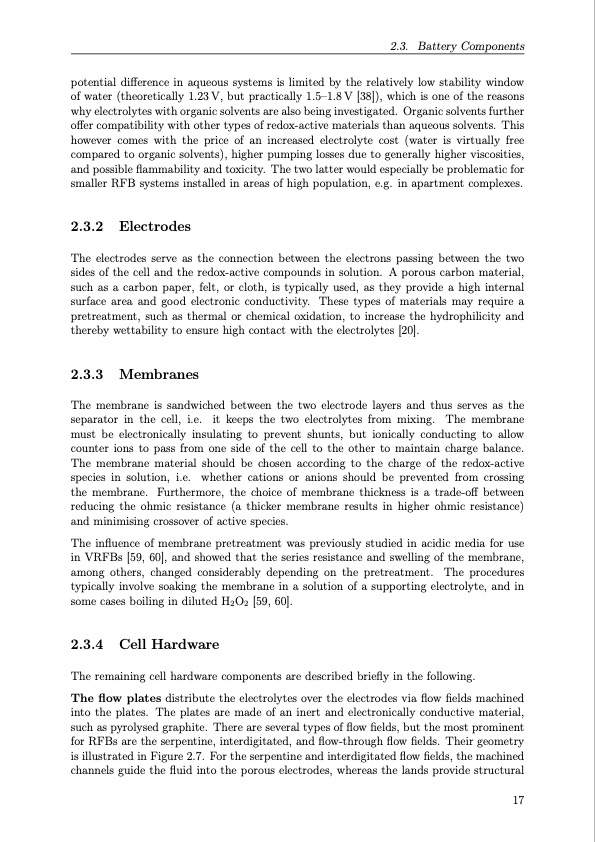
PDF Publication Title:
Text from PDF Page: 038
potential difference in aqueous systems is limited by the relatively low stability window of water (theoretically 1.23 V, but practically 1.5–1.8 V [38]), which is one of the reasons why electrolytes with organic solvents are also being investigated. Organic solvents further offer compatibility with other types of redox-active materials than aqueous solvents. This however comes with the price of an increased electrolyte cost (water is virtually free compared to organic solvents), higher pumping losses due to generally higher viscosities, and possible flammability and toxicity. The two latter would especially be problematic for smaller RFB systems installed in areas of high population, e.g. in apartment complexes. 2.3.2 Electrodes The electrodes serve as the connection between the electrons passing between the two sides of the cell and the redox-active compounds in solution. A porous carbon material, such as a carbon paper, felt, or cloth, is typically used, as they provide a high internal surface area and good electronic conductivity. These types of materials may require a pretreatment, such as thermal or chemical oxidation, to increase the hydrophilicity and thereby wettability to ensure high contact with the electrolytes [20]. 2.3.3 Membranes The membrane is sandwiched between the two electrode layers and thus serves as the separator in the cell, i.e. it keeps the two electrolytes from mixing. The membrane must be electronically insulating to prevent shunts, but ionically conducting to allow counter ions to pass from one side of the cell to the other to maintain charge balance. The membrane material should be chosen according to the charge of the redox-active species in solution, i.e. whether cations or anions should be prevented from crossing the membrane. Furthermore, the choice of membrane thickness is a trade-off between reducing the ohmic resistance (a thicker membrane results in higher ohmic resistance) and minimising crossover of active species. The influence of membrane pretreatment was previously studied in acidic media for use in VRFBs [59, 60], and showed that the series resistance and swelling of the membrane, among others, changed considerably depending on the pretreatment. The procedures typically involve soaking the membrane in a solution of a supporting electrolyte, and in some cases boiling in diluted H2O2 [59, 60]. 2.3.4 Cell Hardware The remaining cell hardware components are described briefly in the following. The flow plates distribute the electrolytes over the electrodes via flow fields machined into the plates. The plates are made of an inert and electronically conductive material, such as pyrolysed graphite. There are several types of flow fields, but the most prominent for RFBs are the serpentine, interdigitated, and flow-through flow fields. Their geometry is illustrated in Figure 2.7. For the serpentine and interdigitated flow fields, the machined channels guide the fluid into the porous electrodes, whereas the lands provide structural 2.3. Battery Components 17PDF Image | Organic Redox Flow Batteries 2023

PDF Search Title:
Organic Redox Flow Batteries 2023Original File Name Searched:
PhD_thesis_final_dorhoff_4_.pdfDIY PDF Search: Google It | Yahoo | Bing
Salgenx Redox Flow Battery Technology: Salt water flow battery technology with low cost and great energy density that can be used for power storage and thermal storage. Let us de-risk your production using our license. Our aqueous flow battery is less cost than Tesla Megapack and available faster. Redox flow battery. No membrane needed like with Vanadium, or Bromine. Salgenx flow battery
| CONTACT TEL: 608-238-6001 Email: greg@salgenx.com | RSS | AMP |